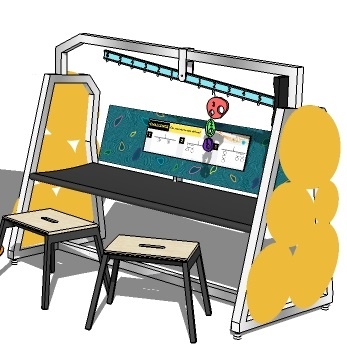Math Content
The research questions that the REVEAL project explored arose during the development and evaluation of the Design Zone exhibit, which was created to engage visitors in algebraic reasoning generally – and specifically in reasoning about functional relationships between quantities. Thus, while the REVEAL study sought to understand museum visitor facilitation in general, it was carried out in the context of exhibits that incorporated math. In order to conduct a rigorous study, the team had to define the kind of mathematical reasoning we hoped visitors would engage in and develop instruments to reliably measure it.
Mathematical Reasoning in REVEAL
Set in real-world contexts of creative problem solving through art, music, and engineering, each Design Zone exhibit component focused on a specific relationship among two or more variables. Through interaction with the exhibit, visitors were encouraged to explore the question: “When <Quantity 1> changes in a particular way, how does <Quantity 2> change?” Once they figured out the relationship, visitors were able to use their understanding to accomplish a task, such as creating a balanced, esthetic mobile or collaboratively completing an Etch-A-Sketch drawing.

For example, at the Balancing Art exhibit used during REVEAL (pictured above), visitors hang pieces of different weights on either side of a pivoting rod in order to create a balanced mobile. Since each piece is marked with its weight and the positions on the rod are labeled with their distance from the center, the exhibit engages visitors with the mathematical relationship among weight, distance, and force that underlies all mobiles: the force that an object exerts is the product of its weight and its distance from the point, or fulcrum, from which the rod is suspended. The other two Design Zone components used in the REVEAL research were Drawing in Motion, an oversized Etch-a-Sketch whose use required collaboration between two people and Designing for Speed/Downhill Race, a game in which visitors rolled wheels down a ramp and explored how the distribution of weights from the center of the wheels changed the wheels’ acceleration.
Measuring Functional Reasoning, Math Awareness, and Math Enjoyment
The REVEAL team created an overall framework for investigating visitors’ functional reasoning by analyzing visitors’ interactions with the three exhibit components. The framework consists of four dimensions: (a) identifying mathematical quantities, (b) describing mathematical relationships, (c) exploring mathematical relationships, and (d) achieving mathematical goals. Rubrics for coding family activity at each exhibit were based on this framework, expressed specifically in the context of the exhibit. The team also developed survey instruments to measure families’ enjoyment of the mathematics and awareness of the mathematics in the exhibit.
